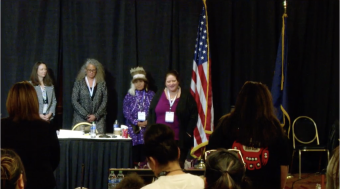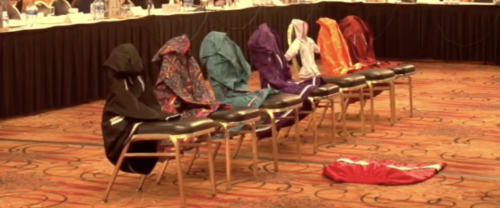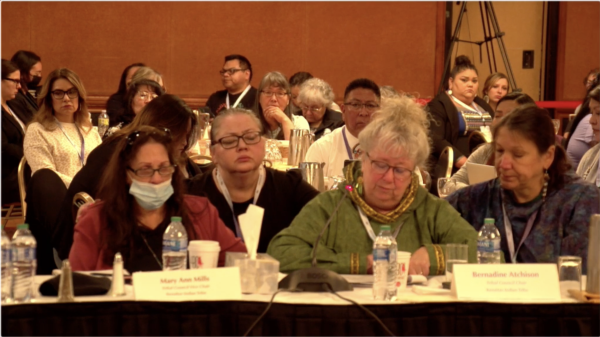Centering Prevention of Missing and Murdered Indigenous Women

Photo courtesy of Paula Julian, NIWRC.
Women Are Sacred In Thought and Actions
The Office on Violence Against Women (OVW) and the U.S. Department of Justice (DOJ) conducted their Violence Against Women Act (VAWA) mandated annual government-to-government consultation on September 21-23, 2022. The first in-person consultation since before the COVID-19 pandemic, with some observers joining virtually.
I was one of the 600 participants and observers who witnessed Tribal leaders, survivors, advocates, grandmothers, mothers, daughters, grandfathers, fathers, and sons testify to the systemic barriers they have faced and recommendations for solutions to violence against women. The barriers are well documented throughout history, including the 1993 Apology to Native Hawaiians and the 2009 Apology to Native Americans.1 These Congressional Resolutions acknowledged and apologized for years of official depredation, ill-conceived policies, breaking of covenants, many instances of violence, maltreatment, neglect, and the long-range economic and social changes that have been devastating to the health and well-being of Native people.
My heart races thinking about the injustices we heard about during consultation, all of which are preventable. The qaspeks that the Yup’ik Women’s Coalition and Alaska Native Women’s Resource Center shared in the ceremony to open and close the consultation and a red skirt that Director Kimberly Lee from Sault Ste. Marie Tribe of Chippewa Indians also shared for missing and murdered Indigenous women (MMIW) are witnesses of the barriers that we must remove to restore sovereignty and increase safety for Native women. What more can we do differently to remove the systemic barriers resulting in domestic violence, sexual assault, stalking, dating violence, sex trafficking, and finally in MMIW?
During the second day of the consultation, a Tribal leader left after providing her testimony after receiving news that her niece was found murdered. Thanks to Councilwoman Gloria Burns from the Ketchikan Indian Community for sharing songs to close the second and the final days of the consultation. Councilwoman Burns’ songs remind us that in the face of injustice, we have hope, we can heal, life continues, and Native peoples are resilient.
What we heard overwhelmingly was that Tribes know best how to respond to violence against women and the federal government must honor and fulfill its trust responsibility to assist Tribes to increase the safety of Native women. Tribal leaders spoke of the importance of ongoing government-to-government consultations to:
- reform and strengthen federal laws and policies;
- appropriate trust resources for local, Tribal responses, including prevention;
- administer trust resources, including grant funds; and
- ensure that perpetrators are held accountable in federal, state, and Tribal systems.
While we continue to reform Tribal, state, and federal justice systems, we must equally invest in the prevention of violence against women as Tribal Chairperson Bernadine Atchison recommended in her testimony:
“To make a change we need to find ways to support our children, so they grow up to be healthy adults. We need to go to ground zero. If we are going to provide safety for our adults we need to do it for our children otherwise you won’t break the cycle of violence and a new generation of violence will continue.”
We must work with our children to heal trauma and ensure they have what they need to live the lives they deserve, safe, thriving, and living to their fullest potential. We must challenge ourselves to transform what we’re doing to ensure that Native peoples are thriving and not only surviving. We must center on “the time period before an individual goes missing or is murdered.”2 This is why Indigenous women’s advocates and shelters play such a critical role in supporting women as they ask for help, and in educating, partnering, and organizing within communities to remove barriers. We have examples of the ways to center the time period before women go missing and/or are murdered throughout Tribal and Native Hawaiian communities, especially rooted in Indigenous cultures and ways of living.3 Indigenous women’s advocates and shelters need greater support, including financially.
“The grassroots movement of survivors, advocates, Tribal leaders, policymakers, and our allies has changed the ‘underpinnings of federal policy’ that are reflected in the rates of violence and other disparities in Indigenous communities. We have provided the political will for policymakers to follow through on recommendations for change.”
—Paula Julian, Filipina, Editor, Restoration Magazine & Senior Policy Specialist, NIWRC
Another leader thanked the survivors who shared their stories at the Consultation and said that survivors’ stories will lead us to stronger futures. Despite feeling angry and frustrated after hearing all the stories of violence against Native women and how some of the same barriers are still in place, we know that we are removing barriers. Our groundswell of advocacy is helping to restore sovereignty and increase safety. The Family Violence Prevention and Services Act (FVPSA), Victims of Crime Act (VOCA), and VAWA are testaments that survivors and the grassroots, including everyone at Consultation can end violence and restore Native women’s respected status. We’re advocating to stop and heal the violence that’s 17+ generations old since 1492 in the lower 48, since 1741 for Alaska, and since 1893 for Hawaii. It will take time, ongoing intentional political strategizing and organizing, and centering Indigenous worldviews.
Teachings shared by Tillie Black Bear, including those of the White Buffalo Calf Woman, tell us women are sacred in thought—respectful behaviors towards women reflect this belief. Related teachings include responsibilities between relatives, with the land and surrounding life we depend on for nourishment, and ceremonies around birth, puberty, marriage, and death. These teachings have governed Indigenous nations maintaining order, balance, and ensuring the health, safety, and prosperity of Indigenous citizens and community members. Our work as advocates, policymakers, leaders, and ultimately our responsibilities to each other as relatives requires us to uncover and share these teachings to uphold and restore women’s sacredness. In this way, we prevent violence against women. In this way, we center “the time period before an individual goes missing or is murdered.”

Photo courtesy of Paula Julian, NIWRC.
The grassroots movement of survivors, advocates, Tribal leaders, policymakers, and our allies has changed the “underpinnings of federal policy”4 that are reflected in the rates of violence and other disparities in Indigenous communities. We have provided the political will for policymakers to follow through on recommendations for change. The annual VAWA Tribal Government-to-Government Consultations have driven federal legislative and policy reform for the past 17 years, providing a consistent dialogue between the Tribal and federal governments on the highest priorities to be addressed.
Recommendations for U.S. Departments of Justice (DOJ), Interior (DOI), Homeland Security (DHS), and Health and Human Services (DHHS)
It is essential that the federal departments increase Tribally based victim advocacy services to prevent MMIW and support their families and community members. The increased services should include but not be limited to the following: counseling for the children and extended family of the victim; funeral services and burial assistance; community healing such as walks for justice and ceremonies to honor MMIW; community meals and gatherings; and other Indigenous-specific activities. Federal departments should implement the following recommendations:
- Implement NCAI recommendations regarding the Office for Victims of Crime Tribal Victim Services Set Aside Program so that the resources reach victims, survivors, and their families.
- DHS should require each DHS office to develop and implement MMIW protocols in consultation with Tribal Nations. DHS is the youngest federal agency, with the largest federal budget after Department of the Defense (DOD), yet only a minuscule amount makes it to Tribal Nations. For example, Customs and Border Protection could coordinate with Tribal Nations on MMIW cases occurring near U.S. Borders, the Transportation Security Agency could train staff on how to identify trafficking victims and coordinate with Tribal Nations, the Cyber Security Infrastructure Security Agency could help train Tribal communities on how to protect against traffickers, the DHS Blue Campaign could offer culturally specific information campaigns for Tribal Nations, and the Federal Emergency Management Agency could coordinate with Tribal Nations to help find victims during or after disasters.
- DHS should establish permanent MMIW staff positions. Currently, DHS has one staff person on detail from the Department of the Interior handling issues. This is not enough staffing to address MMIW within DHS, and there is no guarantee of ongoing MMIW work once the person on detail leaves.
- DHS must staff its Office of Tribal Affairs (OTA) in the Office of Intergovernmental Affairs with at least six staff members. Currently, there is only one career staff position in the OTA, and the person that occupied that position recently left. Where there are a few staff on detail to DHS to help with Tribal issues, the same problem of the lack of follow-through on Tribal issues and MMIW matters once those detail staff ends their tour.
- Fully implement the 2005 VAWA National Institute of Justice research program and provide Tribal Nations information regarding MMIW, including barriers facing Tribes and Native women in P.L. 280 states.
- DOJ and DOI should review, revise, and create law enforcement and justice protocols appropriate to MMIW, including interjurisdictional issues as provided by the Savanna’s Act and Not Invisible Act (NIA).
- Develop protocols, in consultation with Tribal Nations, which recognize the inherent right of AI/AN to exercise their traditional practices to prevent and intervene in response to MMIW. These protocols must address the current violations of Tribal religious and cultural practices of the murdered woman and the disrespectful handling of her remains. The protocols must address the following:
- The cremation of the remains without notice or consent of a family member. In numerous cases like Kaysera Stops Pretty Places, her family did not consent to the coroner’s decision to cremate Kaysera’s body:
- The denial of requests by mothers and other family members to see the bodies of their loved ones. In many cases, the requests to see the remains of the woman have been denied without explanation.
- Mailing and shipping remains without notice to the family and sometimes without proper clothing and modesty covers.
- In adjudicated cases, return of the victim’s personal effects and belongings to the family for proper disposal and/or burial consistent with cultural practices.
- The cremation of the remains without notice or consent of a family member. In numerous cases like Kaysera Stops Pretty Places, her family did not consent to the coroner’s decision to cremate Kaysera’s body:
- Coordinate efforts across all federal departments to increase support for Tribal responses to MMIW as required by Savanna’s Act and by Executive Order 14053.
- Coordinate efforts in consultation with Tribal Nations to increase the response of state governments to cases of MMIW.
- DOJ should investigate state and local agencies, like Montana justice officials with a pattern or practice of inadequately responding to cases of MMIW.8
- DOJ should ensure that data on Indian Country, Tribal Nations, and Tribal Citizens are included in the reports required by Executive Order 14074, Advancing Effective, Accountable Policing and Criminal Justice Practices to Enhance Public Trust and Public Safety. In particular, the reports that contain data from the Accountability Database should include a breakdown of what cases occurred in Indian country and in what BIA region that conduct occurred.
- Implement the recommendations in the section below titled “Accountability of Military and Extractive Industries for Violence Against AI/AN Women.”
- Frequent and regular updates to Tribes communicating NIA Commission work and progress.
Accountability of Military and Extractive Industries for Violence Against Indigenous Women
The federal government must address the escalation of sexual and domestic violence, including sex trafficking, due to the presence of military and extractive industries on or near Tribal lands. The military and defense industry, extractive industries, companies, and subcontractors must be held accountable for the resulting violence from military and itinerant workforces that are used within Indigenous communities by these industries. Indigenous women and communities should not be exposed to violence by felons or serial predators employed by these industries.
Recommendations for the DOJ, DOI, DHHS, DHS, and DOD
- DOJ, DOI, DHHS, DHS, and DOD Army Corps of Engineers should create standards of protection for Tribal communities for industries’ compliance before, during, and after contact to protect Indigenous women and children. The protections must be included throughout the federal permitting processes.
- DOJ should assist Tribal Nations in safeguarding the lives of women from extractive industries that employ a militarized police force. Further protections must be employed to ensure that no militarized tactics and usage of excessive force and/or violations of civil rights are committed against Tribal citizens.
- DHHS should enhance support for services and training for shelter and related advocacy and medical services by developing materials addressing the needs of domestic and sexual violence victims who are victimized by military and itinerant workers who cannot be held accountable by local and Tribal authorities.
- The DOJ, DOI, and DHS should establish screening guidelines to prevent convicted rapists, domestic violence offenders, stalkers, child predators, sex traffickers, and murderers from employment with defense and extractive industries on Tribal lands to prevent predators from accessing vulnerable and often unprotected populations of AI/AN women and children
Caroline LaPorte, former Senior Native Affairs Advisor with NIWRC stated in the February 2019 edition of Restoration Magazine:
“The fact is, MMIW is about more than the law enforcement response or lack of response to violence in Indian country. It’s about the length of time in which American Indians and Alaska Natives have been continuously devalued, fetishized, dehumanized, and discarded. It’s about how genocide and colonization have informed and served as underpinnings in federal policy. It’s about how genocide and colonization were based on the violent thought that land and bodies could be owned and consumed. It’s about how that thought has been allowed to fester and grow and cement itself in the general public’s attitudes towards Indian people and Indian Tribes….We have to focus on vulnerabilities that increase risk if we want to prevent these cases from ever occurring in the first place.”5

Photo courtesy of Paula Julian, NIWRC.
As we reflect on all of the testimony shared at the recent annual VAW consultation, let us remember that while we advocate for continued reform of laws and policies, we have available to us now Indigenous teachings of respect, love, forgiveness, how to care for women and all of our relatives that no one can ever take away from us. This is what we choose to live by day by day, and pass on from generation to generation.
“Through the preparation and hosting of potlatches and feasts, he had demonstrated that learning emerges from strong relationships, authentic experiences, and from curiosity; that learning occurs through observation, contributions, and recognizing and encouraging strengths; and that learning honors the power of the mind, our history, and our stories, as well as spirituality and protocol.”6
1 Public Law 103-150 and Public Law 111-118.
2 MMIW and the Need for Preventative Reform.
3 Examples include NIWRC’s Indigenous Creation Story webinar series, Culture is our Best Protective Factor and Healing Practice, and Stories are our Medicine.
4 MMIW and the Need for Preventative Reform, pg. 31.
5 MMIW and the Need for Preventative Reform.
6 Sara Florence Davidson and Robert Davidson, Potlatch as Pedagogy Learning Through Ceremony, Manitoba, Portage and Main Press, 2018, pgs. 67-68.





